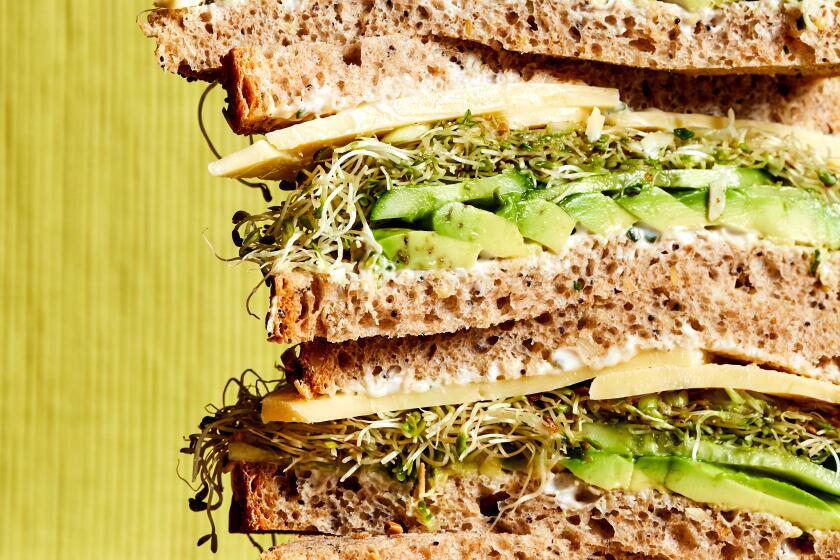The Riddle of the Reds : There Are No Absolutes in the Realm of Taste
Six glasses of red wines of undisclosed origins stood before each of the members of my class, which was devoted to an appreciation of that mysterious California varietal wine called Zinfandel. Each glass had jewel-depths of ruby hue and an intriguing variation in bouquet. With disarming frankness, a question came from the back of the room: âWhat are we supposed to be looking for?â
Donât laugh. The riddle of taste quality in red wines has been going on for centuries, without any positive answers; there are no absolutes in the wild kingdom of taste. Legions of wine snobs will not stray from the classical dictum that the finest claret wines come from Bordeaux and are of Cabernet Sauvignon grape origins. And thousands--not just hundreds--of years of consumer preference will support their argument.
In the days of the Caesars, the Romans regarded the Gallic region surrounding Burdigala, as Bordeaux was known, and the nearby regions of the Rhine as the âimage of Paradise rather than a part of Gaul.â The poet Decimus Magnus Ausonius spent his autumn years at Saint Emilion, cultivating midnight-blue grapes that produced wines much lighter, of more jewel-color than did the grapes from Mediterranean vineyards. In the rocky hills near the Roman consulâs villa, wine is still being made--the Chateau Ausone of St. Emilion.
Only this year, through 7th-Century manuscripts, did research by the Marchese Leonardo Frescobaldi track the origins of these grapes. According to the writings of Pliny and Columella, the grape in the vineyards of Ausonius was called Biturica, and it was known to be hardy and to prosper even in rocky, thin soil. The French called the grape Vidure, which derives from vigne dure (resilient vine). In the 18th Century, the jurist Montesquieu, who codified French law, confirmed this language evolution, which ultimately points to Cabernet Sauvignon as the vine the Romans called Biturica.
In 1884, Charles A. Wetmore, founder of Cresta Blanca in Livermore and the state of Californiaâs first chief viticulturalist, recommended Zinfandel as producing âthe finest wines of Bordeaux type . . . of peculiar Medoc flavors and bouquet . . . destined to assist us in rivaling the most popular of French wines.â
A third-generation Napa Valley wine maker, Michael Martini, has declared: âOnce in the bottle, the Zin character of the fruit begins to fade. At the 10-year level in a blind tasting, people have a hard time telling Zinfandel and Cabernet apart.â
With only this small amount of historical evidence in, where is the answer to my studentâs question? I think it resides in something infinitely more simple than any answers from a vine encyclopedia. In my library of wine books is a rather rare paperback published in 1691, âThe Search after Claret,â by poet Richard Ames. It contains volatile verses against the counterfeit clarets to be found in London taverns, resulting from the governmentâs ban on claret wines from Bordeaux and the substitution of rougher reds that came from the queenâs homeland of Portugal. Ames and his contemporaries were searching for wines with a familiar taste.
So, what are you supposed to be looking for in almost any red wine, any claret-style wine? Answer: Whichever wine you think tastes good. It may be a wine of Cabernet Sauvignon origins, of a blending of other classic Bordeaux vines: Cabernet franc, Merlot, Malbec, Petit Verdot, Carmenere. It could be a well-aged Zinfandel from gnarled old vines. It might even be a California interpretation of red table wine from the Syrah grape of the Rhone with a history that goes all the way back to the times of the Crusaders, who brought vines from the same Persian sources where the Romans had found their beloved Biturica, or Cabernet. There is no Caesar to tell you what you must like--only your own palate.
A press release calls the Inglenook 1982 Napa Valley Cabernet Sauvignon-Reserve Cask ($18.50) âthe overwhelming favorite of the more than 800 enthusiasts in the 1982 California Wine Experience blind tasting.â The runner-up was the Beringer 1982 Knightâs Valley Cabernet Sauvignon ($9); at half the price, I see it as twice the buy.
Here are other good clarets for your holiday shopping list. They are in random order, with minimal taste notes:
Geyser Peak 1983 Reserve Alexandre ($18). A superb Alexander Valley wine.
Robert Mondavi 1982 Napa Valley Cabernet Sauvignon-Reserve ($30). A wine of stylish perfection and finesse.
Laurel Glen 1982 Sonoma Mountain Cabernet Sauvignon ($12.50). Woodsy aromas and intriguing complexity.
Monticello 1983 Napa Valley Cabernet Sauvignon ($10). Intense berryness with deep suggestion of anis in aftertaste.
Grgich Hills 1981 Napa Valley Cabernet Sauvignon ($17). A gold medal-winning wine of round finish and richness.
Paul Thomas 1983 Washington Cabernet Sauvignon ($12). Perhaps hard to find but worth the search.
Creston Manor 1983 Edna Valley Cabernet Sauvignon ($12). Almost floral hints in charming bouquet.
Ernest & Julio Gallo 1980 California Cabernet Sauvignon ($8). Limited Release Reserve with complex aromas.
Rodney Strong 1981 Alexanders Crown Cabernet Sauvignon ($10). Dependable since its first appearance.
Stagâs Leap Wine Cellars 1983 Napa Valley Merlot ($18). An estate-bottled wine of velvet texture and glorious finesse.
Rutherford Hill 1982 Napa Valley Merlot ($10). Long a favorite variety of this dependable Napa Valley winery.
Rodney Strong 1980 Russian River Valley Zinfandel ($6.50). From the âOld Vinesâ of the River West vineyard.
Guenoc 1983 Lake Country Zinfandel ($6.50). Fine grapes beget fine wines, and this is a mellow winner of claret taste.
Fetzer 1984 Lake Country Zinfandel ($5.25). Not the most expensive of the Fetzer Zinfandels, but surely one of the best.
Bonny Doon 1984 Paso Robles Syrah ($12). A symphony of taste that Randall Graham describes as âwhite pepper and anis, raspberry and currants, wild plums, fraises des bois.â
More to Read
Eat your way across L.A.
Get our weekly Tasting Notes newsletter for reviews, news and more.
You may occasionally receive promotional content from the Los Angeles Times.










